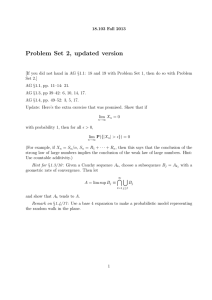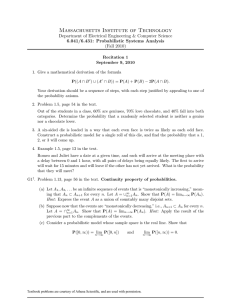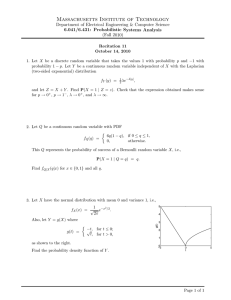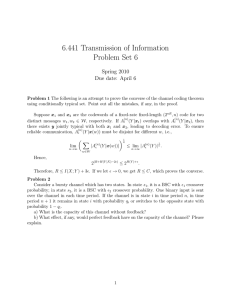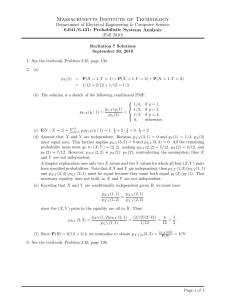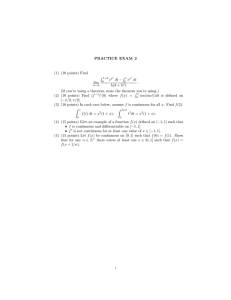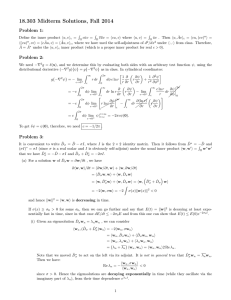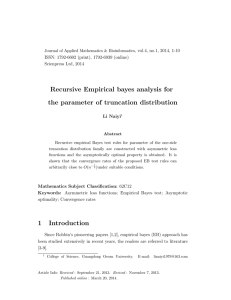Massachusetts Institute of Technology
advertisement
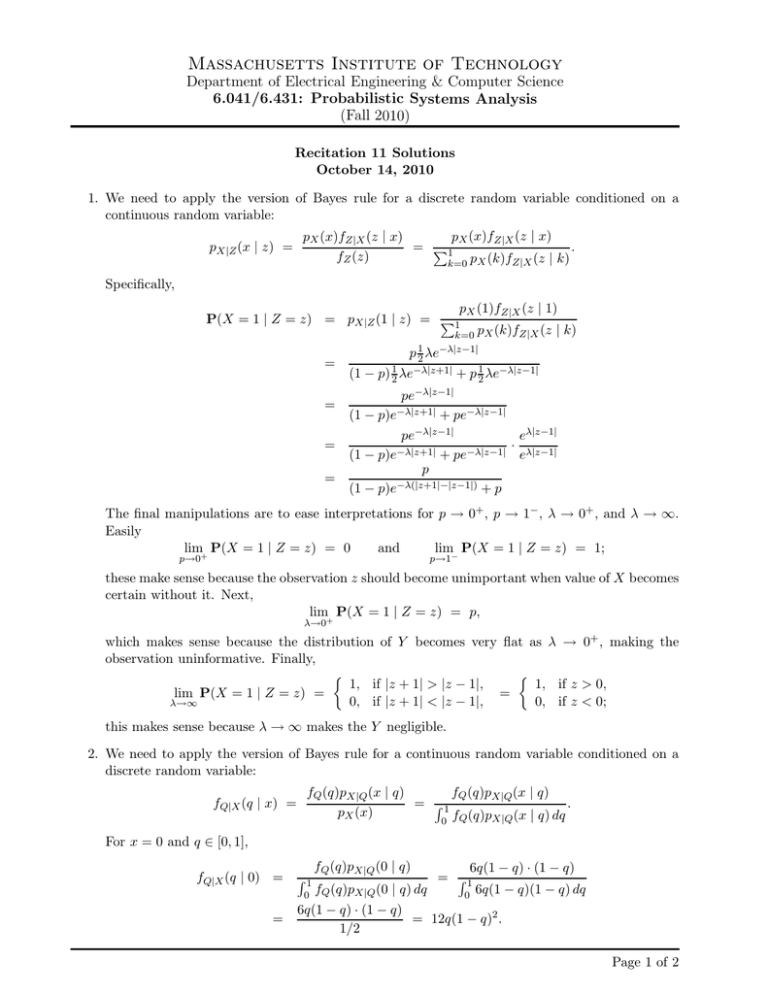
Massachusetts Institute of Technology Department of Electrical Engineering & Computer Science 6.041/6.431: Probabilistic Systems Analysis (Fall 2010) Recitation 11 Solutions October 14, 2010 1. We need to apply the version of Bayes rule for a discrete random variable conditioned on a continuous random variable: pX|Z (x | z) = Specifically, pX (x)fZ|X (z | x) pX (x)fZ|X (z | x) . = �1 fZ (z) k =0 pX (k)fZ|X (z | k) pX (1)fZ|X (z | 1) P(X = 1 | Z = z) = pX|Z (1 | z) = �1 k=0 pX (k)fZ|X (z | k) = = = = p 12 λe−λ|z−1| (1 − p) 21 λe−λ|z+1| + p 12 λe−λ|z−1| pe−λ|z−1| (1 − p)e−λ|z+1| + pe−λ|z−1| pe−λ|z−1| eλ|z−1| · (1 − p)e−λ|z+1| + pe−λ|z−1| eλ|z−1| p −λ(|z+1|−|z−1|) +p (1 − p)e The final manipulations are to ease interpretations for p → 0+ , p → 1− , λ → 0+ , and λ → ∞. Easily lim P(X = 1 | Z = z) = 0 and lim P(X = 1 | Z = z) = 1; p→0+ p→1− these make sense because the observation z should become unimportant when value of X becomes certain without it. Next, lim P(X = 1 | Z = z) = p, λ→0+ which makes sense because the distribution of Y becomes very flat as λ → 0+ , making the observation uninformative. Finally, � � 1, if |z + 1| > |z − 1|, 1, if z > 0, lim P(X = 1 | Z = z) = = 0, if |z + 1| < |z − 1|, 0, if z < 0; λ→∞ this makes sense because λ → ∞ makes the Y negligible. 2. We need to apply the version of Bayes rule for a continuous random variable conditioned on a discrete random variable: fQ|X (q | x) = For x = 0 and q ∈ [0, 1], fQ|X (q | 0) = = fQ (q)pX|Q (x | q) fQ (q)pX|Q (x | q) = �1 . pX (x) f (q)p (x | q) dq Q X|Q 0 fQ (q)pX|Q (0 | q) 6q(1 − q) · (1 − q) = �1 0 fQ (q)pX|Q (0 | q) dq 0 6q(1 − q)(1 − q) dq 6q(1 − q) · (1 − q) = 12q(1 − q)2 . 1/2 �1 Page 1 of 2 Massachusetts Institute of Technology Department of Electrical Engineering & Computer Science 6.041/6.431: Probabilistic Systems Analysis (Fall 2010) For x = 1 and q ∈ [0, 1], fQ|X (q | 1) = = �1 0 fQ (q)pX|Q (1 | q) 6q(1 − q) · q = �1 fQ (q)pX|Q (1 | q) dq 0 6q(1 − q)q dq 6q(1 − q) · q = 12q 2 (1 − q). 1/2 The distributions fQ (q), fQ|X (q | 0), and fQ|X (q | 1) are all in the family of beta distributions, which arise again in Chapter 8. 3. Because of the definition of g, the random variable Y takes on only nonnegative values. Thus fY (y) = 0 for any negative y. For y > 0, FY (y) = P(Y ≤ y) � � = P (X ∈ [−y, 0]) + P X ∈ (0, y 2 ] � � = (FX (0) − FX (−y)) + FX (y 2 ) − FX (0) = FX (y 2 ) − FX (−y). Taking the derivative of FY (y) (and using the chain rule), fY (y) = 2yfX (y 2 ) + fX (−y) � 2 1 � −y4 /2 = √ 2ye + e−y /2 . 2π Page 2 of 2 MIT OpenCourseWare http://ocw.mit.edu 6.041SC Probabilistic Systems Analysis and Applied Probability Fall 2013 For information about citing these materials or our Terms of Use, visit: http://ocw.mit.edu/terms.
